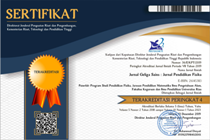Development of Augmented Reality-Based Learning Media on Mechanical Wave Material
Abstract
Augmented reality is one of the most potential technologies for education. Especially in learning Physics for material that is not real. Wave material is one of the appropriate topics if we study it using augmented reality media. The purpose of this research is to develop, validate, and check the reliability of augmented reality-based learning media on mechanical wave material. This research is an R&D research using the ADDIE-type instructional design model. This augmented reality-based media was designed using the Blender, Vuforia, and Unity applications. The Blender application is used to create 3D wave models, Vuforia to create markers, and Unity to create the final application that is displayed on students' androids. This research has produced a 46-page wave material physics module that is integrated with an augmented reality application consisting of 17 markers about waves. The size of the application is 222 Mb with the Apk format on Android version 4.1 Jelly Bean and a 13 MP camera. After testing the validity with 3 experts (experts), namely media experts, material experts, and pedagogic experts as well as 3 expert users (expert users), the average value of an expert and user experts is 4.5 and 4.8 with a maximum score of 5. Media This was also assessed as good by 20 student responses. So that this learning media can be said to be valid according to experts, expert users, and users.
Keywords
Full Text:
PDF (Bahasa Indonesia)References
Arikunto, S. (2014). Prosedur Penelitian Suatu Pendekatan Praktis. PT. Rineka Cipta.
Azhar, A. (2008). Pendidikan Fisika dan Keterkaitannya dengan Laboratorium. Jurnal Geliga Sains, 2(1) Retrieved from https://jgs.ejournal.unri.ac.id/index.php/JGS/article/view/1582
Bakri, F., Ambarwulan, D., & Muliyati, D. (2018). Pengembangan Buku Pembelajaran yang Dilengkapi Augmented Reality pada Pokok Bahasan Gelombang Bunyi dan Optik. Gravity : Jurnal Ilmiah Penelitian Dan Pembelajaran Fisika, 4(2), 46–56. https://doi.org/10.30870/gravity.v4i2.4032
Chaeranti, S. N., Bakri, A., & Permana, A. H. (2018). Modul yang Dilengkapi dengan Teknologi Augmented Reality: Cara Mudah Belajar Fisika untuk Konsep dan Fenomena Kuantum di SMA Kelas XI. Prosiding Seminar Nasional Fisika (E-Journal) SNF2018, VII, SNF2018-PE-118-SNF2018-PE-128. https://doi.org/10.21009/03.snf2018.01.pe.16
Depdiknas. (2020). Penguasan Materi Ujian Nasional. Pusat Penilaian Pendidikan Kementiran Pendidikan dan Kebudayaan. https://hasilun.puspendik.kemdikbud.go.id/#2019!sma!daya_serap!99&99&999!a&04&T&T&1&!1!&
Gusmida, R., Rahmad, M., & Islami, Nur. (2016). Pengembangan Media Pembelajaran Fisika Menggunakan Teknologi Augmented Reality pada Materi Teori Kinetik Gas SMA Kelas XI. Jurnal Online Mahasiswa Fakultas Keguruan dan Ilmu Pendidikan Universitas Riau, 3(2), 1-12.
Khunaeni, L. N., Yuniarti, W. D., & Khalif, M. A. (2020). Pengembangan Modul Fisika Berbantuan Teknologi Augmented Reality pada Materi Gelombang Bunyi untuk SMA/MA Kelas XI. Physics Education Research Journal, 2(2), 83. https://doi.org/10.21580/perj.2020.2.2.6144
Mahmudah, R., Zulirfan, Z., & Rahmad, M. (2022). Analysis of Physics Learning Difficulties in The Topic of Quantum Phenomena of Madrasah Aliyah Students in Indragiri Hulu. Journal of Physics: Conference Series, IOP Publishing, 23091(1), 012089. doi:10.1088/1742-6596/2309/1/012089
Nasir, Muhammad. (2013). Pemrograman Visualisasi Gerak Parabola Sebagai Media Pembelajaran Fisika Dasar dengan Kurikulum Berbasis Kompetensi. Repository.unri.ac.id. https://repository.unri.ac.id/handle/123456789/2324
Nasir, Muhammad, Fakhruddin, Z., & Prastowo, R. B. (2019). Development of Physics Learning Media Based on Self-Efficacy Use Mobile Augmented Reality for Senior High School. Journal of Physics: Conference Series, 1351(1). https://doi.org/10.1088/1742-6596/1351/1/012018
Nasir, Muhammad,. Puspita, AD,. & Fakhruddin, Z (2019). Development of Interactive Learning Media Based on HOTS Material Temperature and Heat. Journal of Physics: Conference Series, 1655(1).
Nasir, Muhammad, Noftiana, N., Islami, N. (2019). Developmental Scratch-Based Online Learning Media in Dynamic Electric Dynamic Topic to Increase Students Concept Understanding in Students Junior High School. Journal of Physics: Conference Series, 1351(1).
Nasir, Muhammad., Prastowo, R. B., & Riwayani (2019). An analysis of instructional design and evaluation of physics learning media of three dimensional animation using blender application. Proceedings - 2018 2nd International Conference on Electrical Engineering and Informatics: Toward the Most Efficient Way of Making and Dealing with Future Electrical Power System and Big Data Analysis, ICon EEI 2018, 2018, pp. 36–41, 8784309
Sudrajat, T. (2020). Penyebab siswa kurang motivasi belajar mas pandemi. Deputy Chief of Program Impact and Creation at Save the Children Indonesia.
Sugiyono. (2017). Metode Penelitian Kuantitatif, Kualitatif, dan R&D. Bandung: Alfabeta.
Hakiki, R, Muchson, M., Sulistina, O., & Febriana, A. (2022). The The Development of Learning Media Based on Augmented Reality, Hologram, and Ludo Game on The Topic of Molecular Shapes. International Journal of Interactive Mobile Technologies (iJIM), 16(04), pp. 70–84. https://doi.org/10.3991/ijim.v16i04.2898
DOI: http://dx.doi.org/10.31258/jgs.10.2.126-133
Refbacks
- There are currently no refbacks.
Copyright (c) 2022 Hafirizka Hafirizka, Muhammad Nasir, Muhammad Syafi’i

This work is licensed under a Creative Commons Attribution 4.0 International License.
Jurnal ini terdaftar dan terindeks pada:
- Crossref
- Google Scholar
- Crossref
- Garuda
- Sinta
- Researchgate
- Dimensions
- Base
- Scilit
- OneSearch
- Road
- CiteFactor
- ResearchBib
- WorldCat



















